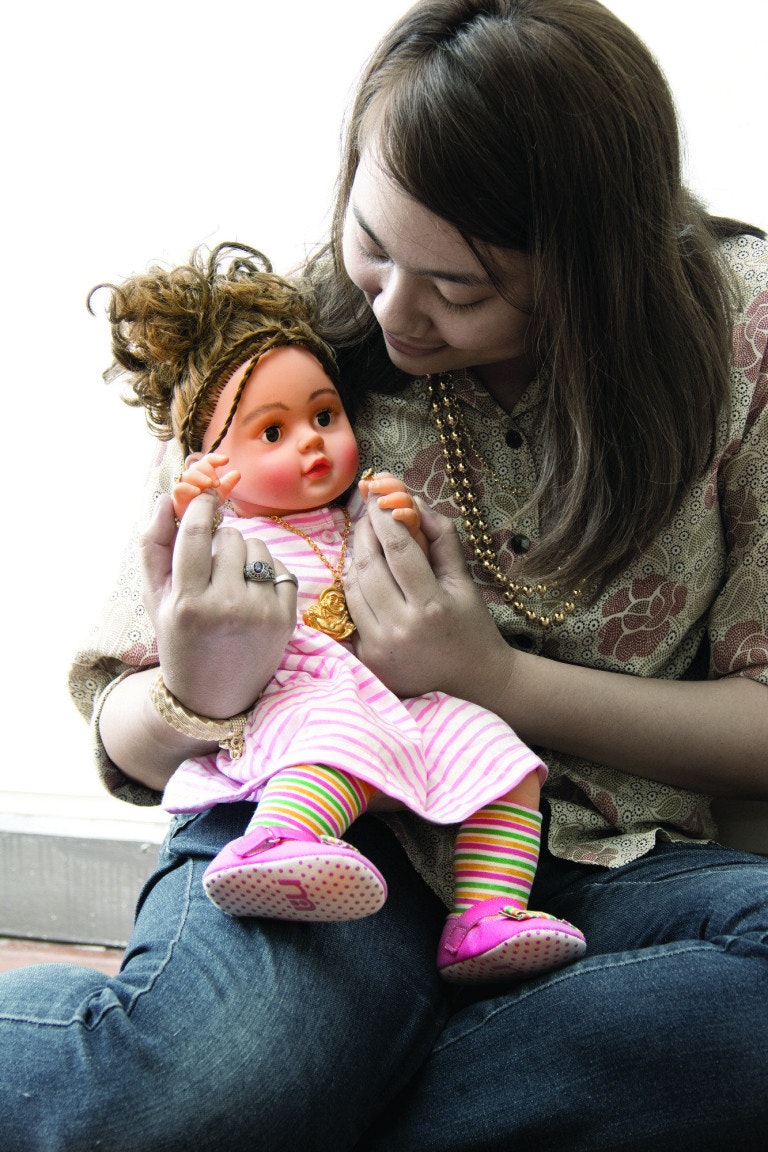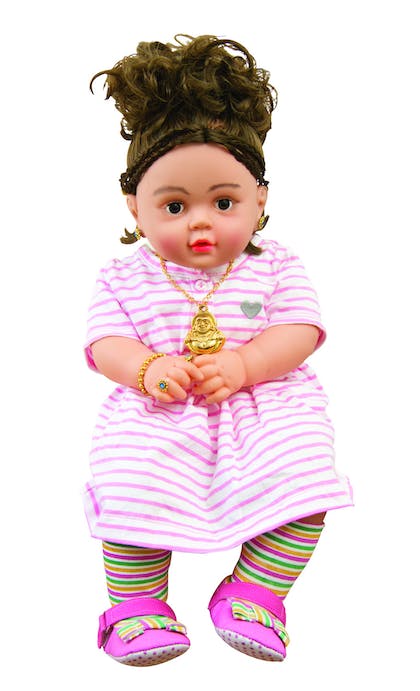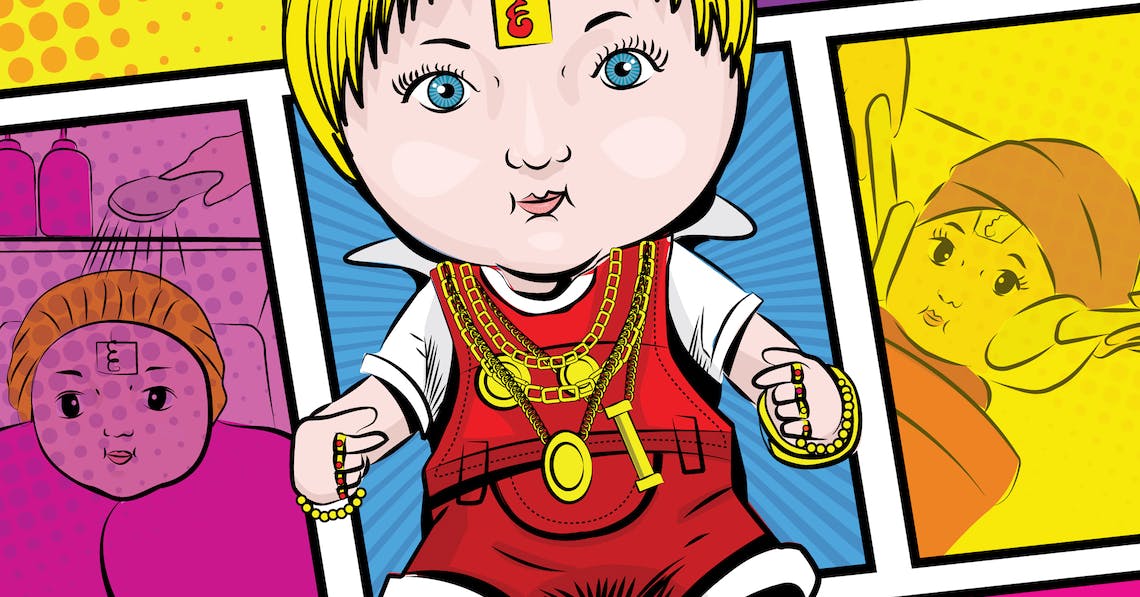“A monk told me there’s an aborted child’s soul in the doll; a witch doctor put it there. He said the doll sends a signal to people in another dimension.”
Had I not lived in Thailand for a decade and a half such a statement might release at least a frisson of consternation, surprise, shock. As it stood this was just another interview featuring another person telling me about people who believe in another world in which spirits roam — a dimension that occasionally spills into ours through the lens of an avid believer, a plane where black magic happily co-exists with more contemporary down-to-earth things such as 7-Eleven and the iPhone 6s.

Welcome to the Thai spirit doll, aka angel doll, aka luk thep, a fairly recent addition to a long list of Thai superstitions. The dolls, some fair of face, some almost elegant, most downright unnerving when met eye to eye, have been taken up by a small group of people to bring them good luck — although it’s debatable whether quite a few owners have taken these creatures on just because it seemed like a good time to revisit a childhood fancy. Owners believe that once a doll has been blessed by a monk through a special ceremony, they are then inhabited by a kindly spirit who will bring good times and blessed luck to its owner.
The man who quoted at the opening of this article is Krishda Krishnaseanee, a writer and magazine editor whose books mostly cover prosaic topics such as business and finance, but who had also written a book about the short-lived — at least in the media — phenomenon of ‘luk thep’ or spirit doll. Prior to interviewing Krishda I had tried in earnest to meet owners of a luk thep, but to no avail. While spirit dolls were for a short time a cause celebre in the Thai media, and to a lesser extent the global media, the owners of such almost-living dolls are thin on the ground – more so now after being scorned and mocked into obscurity on social media.
“There were two waves of luk thep,” said Krishda. The first wave was shrouded in secrecy, localised. The kind of thing one has come to accept in Thailand’s hinterlands. Around April last year, Krishda says, celebrities started to get their hands on the magical dolls which led to a tsunami of popularity. At one point last year luk thep were so in that Thai Smile Airways made it possible to book a seat for the supernatural poppet — only if it followed regulations and buckled up, mind you. Social media exploded with tales of people treating their spooky babies like human beings; restaurants served them dishes, fashionistas would stroll them down pavements in posh prams, ladies were seen faux-breastfeeding their phony toddlers and a bewildering number of selfies with luk thep were featured all over social media. Not only that, many dolls were bedecked in designer clothes, gold and accessories, owners having spent fortunes pampering the supposed spirits which reside beneath the plastic.
Krishda, a diminutive, bespectacled man calls the dolls “nonsense”, explaining that most monks would — and certainly should — hold a similar opinion. It’s his view that this kind of superstition is in no way related to Buddhism, although during the luk thep craze countless monks, it was reported, had blessed the fantastic plastic babies.
Regression Into Childhood
A Chiang Mai psychiatrist, Dr. Pairat Pruksachatkun, mirrored Krishda’s contention that much of the success of the spirit doll, in terms of media coverage and public use, was partly a neatly orchestrated marketing manoeuvre by businesses whose products had been popularised by celebrities and their — perhaps unintentional — endorsements of superstitious beliefs.
Dr. Pairat told me at his clinic on Huay Kaew Road that he believed once celebrities were seen with the dolls, it encouraged people with “insecure and dependent personalities” to follow suit.
“It’s a reflection of childhood,” said the doctor, “to look to a doll for security, kindness, to feel safe. With adults you have to adapt, and that can be stressful. With a doll you have full control,” he added.
While he believes that in some cases such a belief in a living doll can be strange or delusional, he says that for the owners of luk thep that experience can instil positive emotions. You dress your doll nice, take it on holiday, and it responds to your every wish. The owners may be victims of exploitation, he says, but the regression into childhood does bring these people some level of happiness.
“In the past we had the coin, jatukarm rarmathep,” which, he explains, people wore around their necks. The coin was supposed to bring good fortune and protect against bad things happening. The coins disappeared from the scene a long time ago, says the doctor, just as the dolls will disappear. “But something else will come in the future, some other sort of symbol,” he says, explaining that superstitious crazes change just as fashion does. Now he says no one believes in the magical coins and most were abandoned many years ago. Superstition and its products are just like any other kind of consumerism; products must evolve lest they become frowned upon and no longer a necessity.
Quiet Desperation
The dolls, which ostensibly once blessed, contain the good luck spirit of Kuman Thong (a Thai household spirit that brings good fortune), are only one more iteration of an object that is supposed to provide good days ahead.
Just as some forms of making merit in order to attract a slice of good luck is something we see on a regular basis in Thailand, it seems when something new comes along, a remarkable amulet, a doll, a holy piece of fruit, the desperate are often the target market.

Krishda feels that superstition such as this pervades society due to a learned helplessness in many Thai people whose only hope of a better life is a, “holy thing that can rescue them from poverty.” He also said that the owners of dolls he met when researching his book took encouragement from their dolls. “When they suffer they need support,” he said, “and the doll offers that support.”
Where Thai superstition prevails there is usually someone making money out of it. The doll business for a while was bustling, with Facebook pages becoming the popular mode of dealing in spirit dolls. Most dolls would be sold sans spirit, but later taken to a monk or a mor pee (witch doctor) so a Kuman Thong can inhabit the doll.
“There are different grades of dolls,” says Krishda, explaining that some might be a regular children’s doll found in most malls, although high grade dolls such as the ‘Reborn Baby’ or living dolls, are imported and may cost 10,000 baht and up. These dolls, he explains, will have silicon skin, human hair, glass eyes. Some purveyors of such dolls may even tell customers the product has already been blessed and raise the price even more. Consumers can also pre-order materials and put the dolls together themselves.
It’s still happening, Krishda says, but it’s mostly underground now. This is partly because of the backlash on social media where many Thais were calling their compatriots ridiculous. Twitter and Line were where most of the vilifying took place. Here are some examples, in translation:
“Poew just came back. He said that his auntie had taken her luk thep to see the doctor. He is afraid it might have allergies.”
“How?”
“Because of the change in climate.”
This conversation goes on to say how the nurse used a stethoscope on the doll in hospital. Only for the two friends posting to conclude the auntie might be crazy.
Another poster on Twitter asks, “My luk thep wants to watch a movie. Is there any seat for her? I’m afraid she might not be able to see it.” A commenter on the post asks, “What is your brain made from?”
More condemnation:
“Nowadays, people are crazier. Loving a doll more than your own child. Nonsense.”
Perhaps the best we found was this from a taxi driver:
“How did I get to this point? The point that I have to drive a taxi carefully and make sure a luk thep doesn’t get carsick.”
Reading Thai media over the last few months we might be led to believe that this kind of behaviour was widespread, but it is actually only a very small group of Thai people using the dolls, about nth of a percent according to Krishda (although he believes more like 20 percent of Thai people believe that the dolls actually contain a good luck spirit).
“Thai people still live in a state of naivety,” says Krishda, adding that he believes culturally and socially Thai people generally are apt to follow. Critical thinking, or deconstruction of values, is not taught in high school in Thailand, and this he believes this fosters a kind of willingness to believe. At the same time Thailand’s household debt is at dangerous levels, and so in the hopes of creating a better life people naturally cling to the possibility of miracles.
“Most Thais look down on this sort of thing,” says Krishda, but the phenomenon was blown-out of proportion in the media, as such news sells, he says.
Krishda’s conclusion is that, “We are all victims of media and social media – and then business exploits people. In the past such phenomena were small; there were no channels for things like that to spread. But now it’s easier to find a channels, and to exploit people. In the end it’s all about money.”
